
At the heart of a building’s design lies its ability to connect with the external world, and fenestration plays a key role in facilitating this connection. The strategic placement of windows can enhance natural lighting, improve ventilation, and regulate internal temperatures.
In a country like India, where the climate fluctuates between extremes, it’s essential that window designs address both aesthetic and functional concerns to ensure buildings remain comfortable and energy-efficient year-round.
At a recent roundtable session by MyHome by Saint-Gobain, the key aspect of adapting windows and details to meet India’s environmental challenges took centre stage with an emphasis on improving ventilation, managing heat, ease of maintenance and enhancing structural durability.
The panel comprised Ar. Pradeep Varma, Ar. Rohan Rathi, Ar. Rasya Kumar and experts from Saint-Gobain, Mr. Sugumar and Mr.Fahim Mohammed. By utilizing innovative materials, advanced manufacturing, and precise installation processes, windows become not only more functional but also sustainable.
This blog explores the importance of tropicalizing windows in India, emphasizing their role in optimizing ventilation, energy efficiency, and weather resistance, while overcoming the hurdles posed by India’s diverse climate zones.
Tropicalised Window Designs Safeguard Comfort, Energy Efficiency, and Sustainability
India’s vast geographical expanse is home to a variety of climatic conditions, each presenting unique architectural challenges. In predominantly arid desert regions such as Rajasthan and Gujarat, extreme heat demands designs that minimize heat gain while allowing controlled daylight.
The tropics such as Kerala and Tamil Nadu on the other hand, with their high humidity and torrential rains, call for windows that enhance ventilation and prevent water seepage. In the cool mountains of Uttarakhand and Himachal Pradesh, cold weather require windows that retain heat while maximizing natural light. Given this diverse range of conditions, windows become integral to a building’s thermal comfort, energy efficiency, and sustainability.
The principle of tropicalization ensures that window designs cater to the specific environmental needs of tropical regions, contributing to energy savings, enhanced indoor comfort, and supporting eco-friendly construction practices.
Designing windows suited to India’s varied climatic needs involves a blend of aesthetics, functionality, and efficiency.
The following principles are central to the tropicalization process:
India enjoys abundant sunlight, making natural lighting a practical and energy-efficient choice. However, excessive sunlight can lead to overheating and glare.
High-performance solutions, such as Solar Control Glass, allow natural light to enter while minimizing heat gain and blocking harmful UV rays. Shading devices like overhangs, louvers, and blinds are highly effective in reducing direct sunlight in hot climates, preventing indoor overheating. Together, these measures not only lower energy costs by reducing the need for artificial lighting and cooling but also improve overall indoor comfort.
Proper ventilation is essential for improving indoor air quality and maintaining thermal comfort, particularly in humid or densely populated urban areas. Cross-ventilation design, achieved through strategically positioned windows, promotes airflow, reducing humidity and dependence on mechanical cooling systems. The use of sliding, casement, and louvered windows further enhances natural ventilation. In high-rise buildings or restricted spaces, motorized systems can also aid air circulation.
Windows play a critical role in a building’s energy performance, making insulation a key design consideration. Double-glazed or multi-glazed windows enhance thermal insulation, keeping interiors cooler during summers and warmer in winters. UPVC frames, known for their excellent thermal insulation and durability, are a popular choice for green buildings, offering long-term energy savings and sustainability.

UPVC Windows Well-Suited for Indian Tropical Regions
The right materials and features are essential for windows to withstand India’s extreme weather conditions while providing functionality and durability. Here are some examples:
UPVC windows, made from unplasticized polyvinyl chloride, are a highly durable and energy-efficient choice for modern homes. They are particularly well-suited for regions with heavy rains, strong winds, or extreme heat, making them ideal for India’s tropical climate.
Unlike wood, which can warp, or metal, which conducts heat, uPVC frames are insulating, stable and resistant to environmental challenges. The frames are built to withstand prolonged exposure to sunlight without fading or discoloration, thanks to high-quality materials that prevent yellowing over time.
Their multi-chambered design offers superior thermal insulation, helping to reduce cooling costs, while their moisture resistance effectively prevents water seepage during monsoons. UPVC windows also provide excellent noise reduction, making them perfect for urban settings, and require minimal maintenance, just occasional cleaning to stay in top condition.
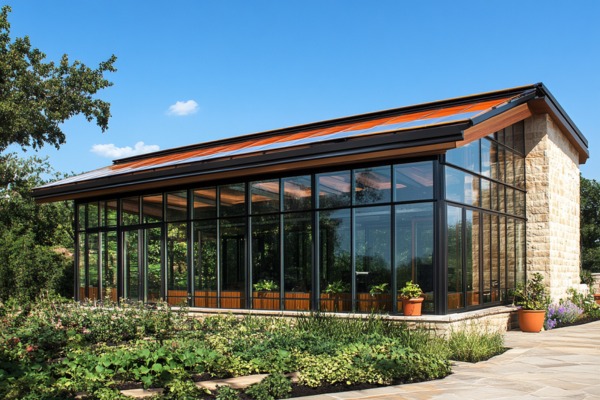
Solar Control Glass Windows Combat Heat Gain and Blocks UV Rays
The type of glass used in windows significantly impacts their performance and energy efficiency. Solar Control Glass is an excellent option as it allows optimal daylight to enter while reducing radiation and reflecting up to 70% of heat. This advanced pyrolytic-coated glass not only offers superior UV protection but also helps maintain cooler indoor temperatures compared to standard clear glass. By keeping interiors cooler, it minimizes the need for air conditioning, thereby enhancing energy efficiency. It features glare resistance and prevents interior furnishings from fading, making it a practical choice.
Tailored for tropical climates like that of in India, the Sun Ban range by Saint-Gobain offers homeowners the flexibility to explore a variety of design possibilities. Available in contemporary colors and various thicknesses, it is ideal for diverse applications such as windows, staircase glazing, facades, and balconies, among others.
Weep holes might be small, but they play a big role in keeping your windows functional and your home dry. A weep hole is a tiny opening at the bottom of a window frame, designed to drain out water and prevent it from accumulating. In tropical countries like India, where humidity and heavy rainfall are frequent, these openings are especially vital for maintaining the integrity of your windows and interiors.
Not only do weep holes help manage rainwater, but they also handle condensation, ensuring your living space stays moisture-free. To improve drainage, larger and multiple weep holes or dedicated water channel tracks are added to window frames. Even if dirt or debris clogs them, cleaning a weep hole is quick and hassle-free, making it a practical feature for any window design.
Weatherproof seals and durable frames are vital for the long-term performance of windows in tropical climates, especially in regions prone to extreme weather. High-quality seals effectively prevent air and water leaks, safeguarding against energy loss and potential structural damage. Sturdy frames, particularly those made from premium materials like UPVC, ensure structural integrity and resist warping or degradation over time.
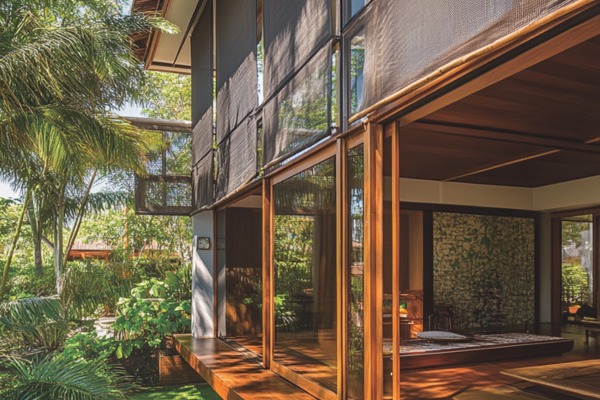
Integrated Mosquito Mesh Ensures a Pest-Free and Well-Ventilated Living Space
In tropical climates, the combination of high humidity and warm temperatures creates an ideal breeding ground for mosquitoes and other insects. This can lead to increased discomfort and potential health risks.
To combat this, it’s essential to consider the seamless integration of mosquito mesh into window designs. The addition of a fine mesh screen can effectively keep insects out while allowing for proper ventilation, ensuring a comfortable living environment. By incorporating mosquito nets in windows, homeowners can enjoy the benefits of natural airflow without worrying about pests.
Whether for residential or commercial projects, selecting the right windows can transform spaces into a comfortable haven. In India’s diverse climate, the tropicalization of windows is essential. By optimizing daylight, enhancing ventilation, and improving thermal insulation, windows significantly contribute to energy-efficient, comfortable, and sustainable buildings.
Saint-Gobain offers a plethora of glass solutions to perfectly suit the various needs for windows tailored to India’s climate, combining innovative materials, cutting-edge technology, and seamless customer service. As climate-responsive architecture gains momentum, tropical windows are not just solutions for today but investments in a greener, more sustainable future.
What is tropicalization in window design, and why is it necessary in India?
Tropicalization involves designing windows to suit tropical climates by optimising daylight, ventilation, thermal insulation, and weather resistance. This ensures energy efficiency, comfort, and durability in diverse climatic zones across India.
How can windows help with energy efficiency in India’s diverse climate zones?
Windows equipped with double-glazed or multi-glazed glass provide better thermal insulation, keeping interiors cool during summers and warm during winters. Additionally, materials like uPVC frames enhance energy efficiency by preventing heat transfer and reducing cooling costs while providing excellent noise reduction, making them perfect for urban settings.
What type of glass should we use for windows in India?
In India's tropical climate, Solar Control Glass is highly recommended. It allows natural light to enter while minimising heat gain and blocking harmful UV rays.
What are the benefits of using SGG Sun Ban Solar Control Glass in buildings?
The benefits of using Sun Ban Solar Control Glass include improved energy efficiency, reduced glare, and enhanced comfort by maintaining a stable indoor temperature. This glass also protects interiors from UV rays, which can help prevent fading of furniture and flooring.